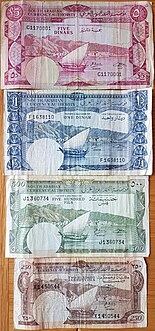 W
WSouth Yemen, officially the People's Democratic Republic of Yemen, also referred to as Democratic Yemen or Yemen (Aden), was a socialist country that existed from 1967 to 1990 as a state in the Middle East in the southern and eastern provinces of the present-day Republic of Yemen, including the island of Socotra.
 W
WThe Federation of the Emirates of the South was an organization of states within the British Aden Protectorate in what would become South Yemen. The Federation of six states was inaugurated in the British Colony of Aden on 11 February 1959, and the Federation and Britain signed a “Treaty of Friendship and Protection,” which detailed plans for British financial and military assistance. It subsequently added nine states and, on 4 April 1962, became known as the Federation of South Arabia. This was joined by the Aden Colony on 18 January 1963.
 W
WThe South Yemen national football team was the national team of South Yemen between 1965 and 1989. The team took part in the Asian Cup finals in 1976, losing 0–8 to Iran and 0–1 to Iraq. They entered their only World Cup qualification campaign, for the 1986 FIFA World Cup, and were knocked out in the first round by Bahrain.
 W
WHadhramaut is a region in South Arabia, mostly in present-day eastern Yemen, and part in Western Oman and Southern Saudi Arabia. The name is of ancient origin, and is retained in the name of the Hadhramaut Governorate of Yemen. The people of Hadhramaut are called Hadhrami. They formerly spoke Hadramautic, but now predominantly speak Hadhrami Arabic.
 W
WThe NDF Rebellion was an uprising in the Yemen Arab Republic by the National Democratic Front, under Yahya Shami, between 1978 and 1982.
 W
WSouth Yemen competed as the Yemen Democratic Republic at the 1988 Summer Olympics in Seoul, South Korea. It was the only time that the nation would compete at the Olympic Games. After unification with North Yemen, the nation would later return as Yemen at the 1992 Summer Olympics.
 W
WThe Popular Front for the Liberation of the Occupied Arabian Gulf, later renamed the Popular Front for the Liberation of Oman and the Arabian Gulf, was a Marxist and Arab nationalist revolutionary organisation active in an armed struggle against the Arab monarchies in the Arabian Peninsula. The organization was dedicated to overthrow all monarchies in Arabia culminating in the Dhofar revolution against the Sultanate of Oman.
 W
WThe Security Belt Forces is a paramilitary force based in Southern Yemen and forms the elite military wing of the Southern Transitional Council. The force operates in the governorates of Aden, Lahij and Abyan and is trained and heavily supported by the United Arab Emirates Armed Forces. The Security Belt has fought against Islah, al-Qaeda in the Arabian Peninsula and the Islamic State of Iraq and the Levant’s Yemeni branch.
 W
WThe Federation of South Arabia was a federal state under British protection in what would become South Yemen. Its capital was Al Attihad.
 W
WThe South Yemeni Civil War, colloquially referred to as The Events of '86 or The Events of January 13, or more simply as The Events, was a failed coup d'etat and armed conflict which took place on January 13, 1986 in South Yemen. The civil war developed as a result of ideological differences, and later tribal tensions, between two factions of the ruling Yemeni Socialist Party (YSP), centred on Abdul Fattah Ismail's faction, al-Toghmah, and Ali Nasir Muhammad's faction, al-Zomrah, for the leadership of the YSP and the PDRY. The conflict quickly escalated into a costly civil war that lasted eleven days and resulted in thousands of casualties. Additionally, the conflict resulted in the demise of much of the Yemeni Socialist Party's most experienced socialist leadership cadre, contributing to a much weaker government and the country's eventual unification with North Yemen in 1990.
 W
WThe dinar was the currency of South Arabia and then South Yemen between 1965 and 1990. It was subdivided into 1000 fils (فلس). After Yemen's monetary unification on 1 July 1990, it was one of the two official currencies used in Yemen Republic until 11 June 1996.
 W
WThe State of Aden was a state constituted in Aden within the Federation of South Arabia. Following its establishment on 18 January 1963, Sir Charles Johnston stepped down as the last Governor of Aden.
 W
WUnited Nations Security Council Resolution 243, adopted unanimously on 12 December 1967, after examining the application of the People's Republic of Southern Yemen for membership in the United Nations, the Council recommended to the General Assembly that the People's Republic of Southern Yemen be admitted.
 W
WThe First Yemenite War was a short military conflict between the Yemen Arab Republic and the People's Democratic Republic of Yemen.
 W
WThe Second Yemenite War was a short military conflict between the Yemen Arab Republic and the People's Democratic Republic of Yemen. The war developed out of a breakdown in relations between the two countries after the president of North Yemen, Ahmad al-Ghashmi, was killed on 24 June 1978 and Salim Rubai Ali, a moderate Marxist who had been working on a proposed merger between the two Yemens, was murdered two days later. The hostility of the rhetoric from the new leadership of both countries escalated, leading to small scale border fighting, which then in turn escalated into a full blown war in February 1979. North Yemen appeared on the edge of a decisive defeat after a three-front invasion by South Yemeni combined arms formation, however this was prevented by a successful mediation in the form of the Kuwait Agreement of 1979, which resulted in Arab League forces being deployed to patrol the North-South border. An agreement to unite both countries was also signed, although was not implemented.